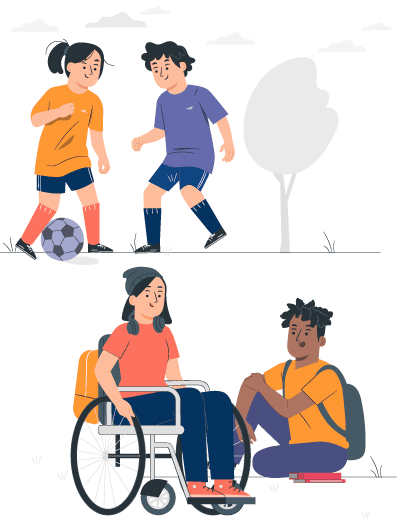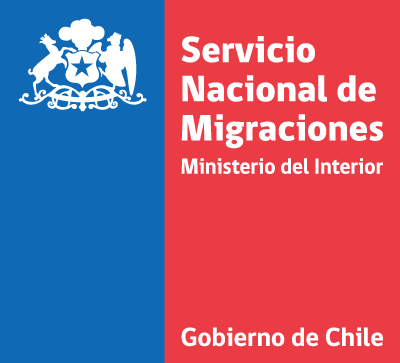Situation of children and adolescents (NNA)

- It is a free residence permit. Therefore, there is no fee to be paid during the application process.
- No payment of penalties nor initiation of the “Declaración voluntaria de ingreso clandestino” (Voluntary declaration of clandestine entry) procedure are required to start the process.
- This permit may be granted regardless of their immigration status or the immigration status of the child’s parent or guardian in Chile.
- The grant of this residence permit will not be a benefit extensible to other members of the family group or person in charge of the child’s care.
Where can I submit this application?
The application can be made on the SERMIG’s Portal de Trámites Digitales, by logging in “Residencia Temporal en Chile“.
* Procedure available only from within Chile.
Requirements and information
Who can apply?
The residence application may be submitted directly by the child or adolescent; by the parent or caregiver; or by the SENAME or Mejor Niñez institution.
Applicants must provide proof of parentage by means of the corresponding birth certificate.
To certify the personal care or guardianship, they must present the documents granted by the entity that is competent according to the law in force in the State that granted the personal care or guardianship.
Remember!
This permit will not be a benefit extensible to the members of the family group, guardian or person in charge of the personal care of the child or adolescent.
What documents do I need to apply for this permit?
-
If the child or adolescent lives with their parent:
- Identity card or passport of the child or adolescent.
- Tarjeta Única Migratoria (TUM), for entry through an authorized border crossing.
- Birth certificate of the child or adolescent.
- Recent photo:
- In color, with a white background.
- Looking directly at the camera, covering the entire face, with a neutral expression and open eyes.
- Do not wear accessories such as glasses or a hat.
- It must be taken on a current date, as close as possible to the time of application.
- Upload to the platform in JPG or PNG format.
- Affidavit signed before a notary public (Certificado de cuidado y expensas in spanish), which must be signed before a notary with an advanced electronic signature.
- Proof that the child or adolescent is in Chile must be provided by attaching one of the following documents:
- Health records (child check-up, vaccination records, among others) issued by the Family Health Department (CESFAM) or private health provider where the child is attended in Chile.
- School records issued by the public or private educational institution where the child goes to in Chile (regular student certificate, proof of enrollment, among others) or proof of enrollment from the School Admission System (SAE).
-
Disability status:
Certificate of Registration in the National Disability Registry (RND) issued by the Registro Civil; or Disability Certification Resolution issued by COMPIN (Preventive Medicine and Disability Commission); or Certificate issued by the competent official institution of the country of origin, duly legalized or apostilled, as appropriate. - Identity card or passport of the parent.
-
If the child or adolescent lives with their parent:
-
If the child or adolescent lives with a guardian:
- Identity document or passport of the child or adolescent.
- Tarjeta Única Migratoria (TUM), for entry through an authorized border crossing.
- Birth certificate of the child or adolescent.
- Document that certifies personal care or guardianship (only for children and adolescents not accompanied by their parents), issued by the competent authority of the granting country.
- Affidavit signed before a notary public (Certificado de cuidado y expensas in spanish), which must be signed before a notary with an advanced electronic signature.
- Proof that the child or adolescent is in Chile must be provided by attaching one of the following documents:
- Health records (child check-up, vaccination records, among others) issued by the Family Health Department (CESFAM) or private health provider where the child is attended in Chile.
- School records issued by the public or private educational institution where the child goes to in Chile (regular student certificate, proof of enrollment, among others) or proof of enrollment from the School Admission System (SAE).
-
Disability status:
Certificate of Registration in the National Disability Registry (RND) issued by the Registro Civil; or Disability Certification Resolution issued by COMPIN (Preventive Medicine and Disability Commission); or Certificate issued by the competent official institution of the country of origin, duly legalized or apostilled, as appropriate. - Identity card or passport of the person responsible for the care of the child or adolescent in Chile.
-
If the child or adolescent lives with a guardian:
-
If the child or adolescent is in a SENAME or Mejor Niñez program:
SERMIG maintains current agreements with these services, which are responsible for submitting a residence application on behalf of the Children and Adolescents (NNA) who are admitted to their programs.
What happens when the child is unaccompanied or there is no certainty about their identity or age?
In the event of uncertainty about the identity and age of a foreigner, the background information will be made available to the authority responsible for the protection of children and adolescents, in accordance with current legislation, in order to safeguard their rights.
In those cases in which an unaccompanied child or adolescent enters the national territory, and is not in another of the cases provided for above, it shall be the responsibility of the authority in charge of the protection of children and adolescents according to the legislation in force to apply for a Residencia Temporal permit in favor of those who are placed under their care or protection, ensuring at all times the best interest of the child or adolescent.
In no case shall a criminal record certificate be required from children and adolescents.
As for the absence of a passport or identity card, this should not affect their immigration status, and in this regard the provisions of the third, fourth and fifth paragraphs of Article 14 of the Regulation of Law No. 21.325 (PDF, spanish only) shall apply.
What should I do after obtaining the Residencia Temporal permit?
Once the Residencia Temporal permit is granted, you must download the Estampado Electrónico that certifies the migratory benefit, and then you must request an appointment at the Servicio de Registro Civil e Identificación (Civil Registry and Identification Service) to obtain the Cédula de Identidad (Identity Card).
Legal framework
- Decree No. 177 of 2022, establishes the immigration subcategories of the Residencia Temporal permit.
-
Important
The child or adolescent applicant can complete the application process using their own account, independently of their parent or guardian's account and/or application.
- If they do not have an account, they must create one in the Application Portal. It is important that the account be created with the child's personal information: first name, last name, date and country of birth, and email address.
- If the child or adolescent applicant has a Chilean RUN and is over 14 years old, they can apply using ClaveÚnica. If they do not remember it, they can request a password recovery.
What other humanitarian reasons exist?
Important!
- For foreigners who are inside Chile as Permanencia Transitoria holders, they must submit a copy of the Tarjeta Única Migratoria (TUM) or a copy of the entry stamp in their passport.
- Documents issued in any language other than Spanish and English must be translated and legalized by the respective Consulate.
- All documents issued abroad or by the respective consular representation in Chile must be apostilled or duly legalized, as stipulated in Articles No. 345 and 345 bis of the Código de Procedimiento Civil (Code of Civil Procedure).
- Documents issued by private parties must be submitted within 30 days from the date of issuance. Those issued by public institutions and agencies must be presented within 60 days from the date of issuance, unless the validity of the document is different from that indicated.
- All documents must be submitted in PDF format.
Why is the regularization of children and adolescents in Chile important?
The migratory regularization of NNA is
important for the protection of their rights.

